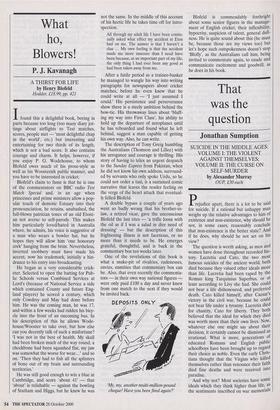That was the question
Jonathan Sumption
SUICIDE IN THE MIDDLE AGES: VOLUME I: THE VIOLENT AGAINST THEMSELVES; VOLUME II: THE CURSE ON SELF-MURDER by Alexander Murray OUP, £30 each Prejudice apart, there is a lot to be said for suicide. If a rational but unhappy man weighs up the relative advantages to him of existence and non-existence, why should he not, in some cases, reasonably conclude that non-existence is the better state? And if he does, why should he not act on his view?
The question is worth asking, as men and women have done throughout recorded his- tory. Lucretia and Cato, the two most famous suicides of the ancient world, both died because they valued other ideals more than life. Lucretia had been raped by the Roman king Tarquinius Superbus, or at least according to Livy she had. She could not bear a life dishonoured, and preferred death. Cato killed himself, after Caesar's victory in the civil war, because he could not bear life under a tyranny. Lucretia died for chastity, Cato for liberty. They both believed that the, ideal for which they died was worth more than their own lives. Now, whatever else one might say about their decision, it certainly cannot be dismissed as irrational. What is more, generations of educated Romans and English public schoolboys have been brought up to regard their choice as noble. Even the early Chris- tians thought that the Virgins who killed themselves rather than renounce their faith died fine deaths and were received into paradise. And why not? Most societies have some ideals which they think higher than life, as the sentiments inscribed on war memorials show in our own century. And, although the moment of death may be painful, one cannot miss one's life after it has ended, as one may miss one's liberty, honour or self- respect before. This was, broadly speaking, the view taken by Roman law, the only advanced system of law which has ever for- mally sanctioned suicide. Suicide provoked by 'physical pain or weariness of life' was no crime, wrote Antonius Pius in one of his rescripts. Dolore aliquo corporis aut taedio vitae: there in six words is the rational free- dom of choice insinctively abhorred by right-thinking people ever since.
The title of Alexander Murray's book hardly does justice to his work. Although mainly concerned with the Middle Ages, it repeatedly looks back to the first Christian centuries and the ancient world, and for- ward to modern times. In one, admittedly trivial, sense, suicide in the Middle Ages was much like suicide in any other time. The many men and women who found that misery and fear of the future outweighed their own deepest moral instincts and fear of death seem very like their ancient and modern counterparts. The technology of suicide has hardly changed. The motives are much the same. The survivors felt the same anger and disgust, tinged with the same pity. Suicide is a tiny subject, an infinitely minor human activity. Yet it engages some of the strongest instincts and the profoundest reflections of humanity.
In order to reject the Roman law view that suicide was a legitimate choice of rational men, it is necessary to believe that men owe their lives to others, and are not therefore free to dispose of themselves as they please. Those ancient philosophers, such as Seneca, who regarded suicide as morally acceptable, rejected this view in the name of personal autonomy of men. Suicide was only necessarily wrong in their eyes if it was committed by those who had no autonomy, for example because they were slaves who owed their lives to their master, or men out of their minds who were incapable of rational choice. But mediaeval men rejected the idea that individuals were autonomous, and believed with great intensity that they owed their lives to others than themselves. Believing, as they did, in an all-creating God to whom Men would have to account for their lives, they were bound to regard self-murder as one of the worst imaginable sins. And, just as a man's life belonged to God in the eyes of theologians, so it belonged to his lord in the same way as a slave. But a free man was the property of all those to whom he owed obligations: to his feudal lord, to his City, to the king. His suicide destroyed their property. We know as much as we do about mediaeval suicides mainly because of the rigour with which these authorities looked out for suicides in order to forfeit property.
The ancient and the mediaeval view of the matter are both perfectly logical responses to very different worlds. It is only our own age which has difficulty in thinking clearly about suicide. For we have by and large accepted the notion of the personal autonomy of men devoted to the pursuit of happiness, and rejected the idea of an all- creating God who will judge what use we make of our lives. Yet the almost universal abhorrence of suicide persists. Why?
Murray has skilfully reconstructed the views of the lawyers and theologians who articulated their thoughts on these difficult questions. But he has also achieved some- thing much more remarkable. He has explored the instincts of the mass of men who shared the great taboo against suicide without even trying to give it a philosophi- cal basis. The range of his reading is aston- ishing, extending over more than ten centuries and across every western Euro- pean country. Yet he wears his learning lightly, writing in an engaging, rather avun- cular style, addressing the reader directly, expounding his methods and conclusions as he goes along, with elegance and as much humour as the beastliness of the subject permits. A minor subject is not the same as an obscure one, and this gem of historical research provokes, as the best history should, thoughts extending well beyond its own boundaries.



























































































 Previous page
Previous page